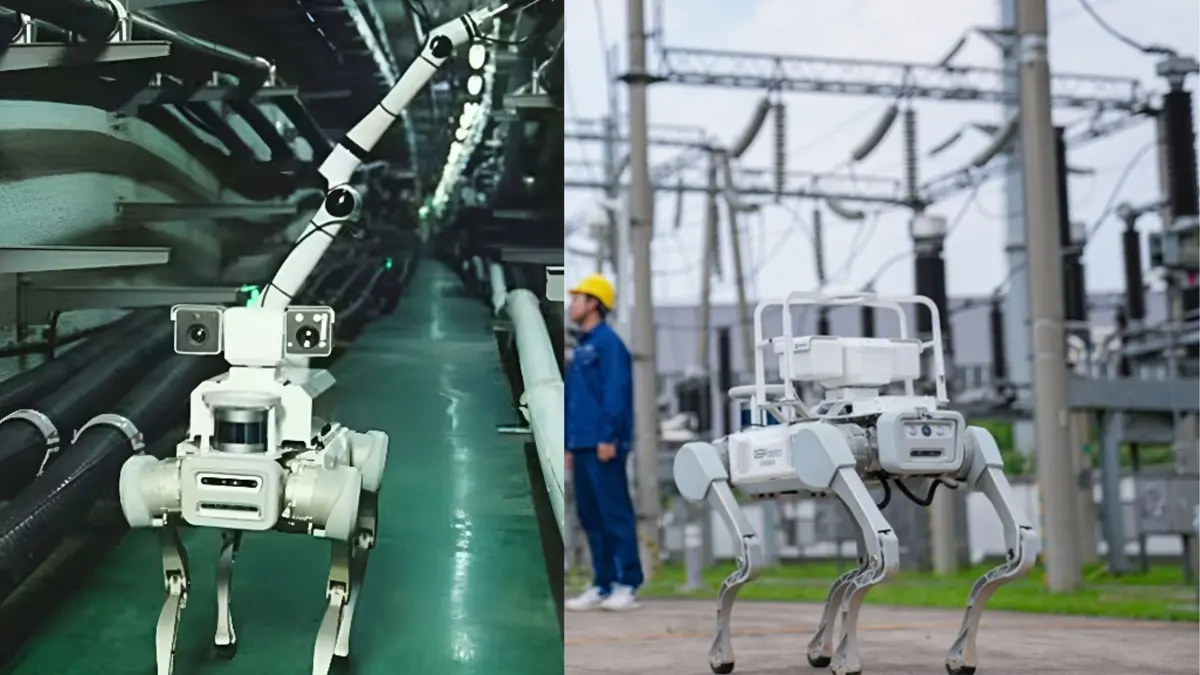In a groundbreaking move towards autonomous green energy, China has launched the world’s first robot dog patrolled wind farm, eliminating the need for onsite human workers. The Ningxia Tongli Third Wind Farm, located in the harsh desert landscape of north central China, is being hailed as a symbol of the future where artificial intelligence, robotics, and clean energy converge to power human civilization.
A Revolution in Renewable Energy Operations
Since its silent activation in September 2024, the 70 megawatt facility has operated entirely human free, a feat made possible through advanced technologies. Built by China Three Gorges, a state owned clean energy giant, and equipped with Goldwind GW150-3 MW turbines, the wind farm represents a new paradigm in infrastructure management.
Its star operators? Four legged robotic dogs, a fleet of surveillance drones, and a sophisticated mesh of smart cameras and IoT sensors. These autonomous units patrol the facility, detect anomalies in real time, and provide live feedback to cloud systems. This allows remote teams hundreds of miles away to maintain complete control over the site, reducing labor costs and enhancing safety.
The robot dog wind farm is not just an engineering marvel it’s a practical response to the challenges of desert environments, where scorching heat, high winds, and sandstorms make human presence costly and dangerous. In this environment, robotic dogs equipped with thermal cameras and AI driven diagnostics walk among the turbines, capturing data, identifying faults, and even performing minor interventions.
These robotic dogs are designed by Chinese robotics firms to be highly durable, agile across uneven terrain, and capable of operating 24/7. Their performance has already set a new benchmark in how critical infrastructure can be maintained without boots on the ground.
The End of Traditional Operations?
Dr. Mei Ling, AI and Robotics Professor at Tsinghua University, explains, The deployment of robotic dogs in a fully autonomous wind farm is not just symbolic it signals a leap in what AI powered maintenance can accomplish. We’re seeing the emergence of a truly smart infrastructure where humans supervise, but machines act.
Indeed, the robot dog wind farm marks a shift in labor dynamics. Instead of engineers and technicians stationed onsite, highly trained remote teams now interpret machine generated reports, dispatch automated routines, and make strategic decisions based on real time analytics.
Automation Success in the Gobi
China’s desert regions, particularly in Inner Mongolia and Ningxia, have long been targeted for wind energy development due to strong wind currents and vast open spaces. Yet until now, the challenge was operational sustainability. In 2021, a previous wind farm in the Gobi Desert saw delays and maintenance issues due to insufficient workforce adaptation to climate challenges.
By contrast, the robot dog wind farm has run without disruption for nearly a year. Maintenance downtime has been reduced by 60%, and energy production efficiency has improved thanks to AI driven performance optimization. This case demonstrates not only the feasibility but the advantage of full automation in remote and hostile terrains.
A Worker’s Perspective
Zhao Qiang, a former field technician who now monitors multiple wind farms from a control center in Beijing, shares. I used to spend 15 days at a time in the desert. The conditions were brutal heat, isolation, danger. Now, I oversee five sites from a cooled, AI integrated command center. It’s safer, more efficient, and strangel more human.
His experience illustrates how the robot dog wind farm hasn’t replaced human intelligence but rather augmented it, freeing workers from physical risks and allowing them to focus on higher level tasks.
The Global Impact and Future of Robot Assisted Wind Farms
Globally, the renewable energy sector is grappling with two major challenges: safety and labor shortages. The success of China’s project suggests that robot dog wind farms could offer a scalable solution. Countries with vast and difficult terrains, such as the U.S Australia, and regions in Africa, are closely watching this model.
According to McKinsey & Company, automation in energy infrastructure could reduce O&M (operations and maintenance) costs by up to 40% globally. This not only enhances profitability but also accelerates the path toward zero carbon operations.
Ethics, Cybersecurity & Dependence on AI
Despite its success, the robot dog wind farm raises critical questions. What happens if the AI fails or is hacked? Who is accountable in case of an error? As we build smarter energy systems, cybersecurity and AI ethics must evolve in tandem to ensure reliability and trust.
The launch of the world’s first robot dog wind farm is not merely a tech stunt it is a major leap forward in the global clean energy transformation. With zero humans on site, the integration of robotics, AI, and sustainable energy systems presents an inspiring vision of a safer, more efficient future.
While challenges remain, the experiment in the Chinese desert has proven one thing beyond doubt the future of energy might just walk on four legs.

